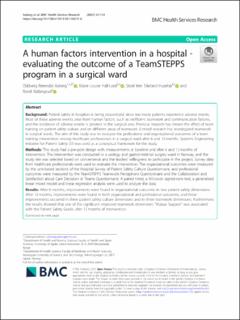| dc.contributor.author | Aaberg, Oddveig Reiersdal | |
| dc.contributor.author | Hall-Lord, Marie Louise | |
| dc.contributor.author | Husebø, Sissel Iren Eikeland | |
| dc.contributor.author | Ballangrud, Randi | |
| dc.date.accessioned | 2021-04-28T08:20:21Z | |
| dc.date.available | 2021-04-28T08:20:21Z | |
| dc.date.created | 2021-02-03T13:48:45Z | |
| dc.date.issued | 2021 | |
| dc.identifier.issn | 1472-6963 | |
| dc.identifier.uri | https://hdl.handle.net/11250/2740074 | |
| dc.description.abstract | Background
Patient safety in hospitals is being jeopardized, since too many patients experience adverse events. Most of these adverse events arise from human factors, such as inefficient teamwork and communication failures, and the incidence of adverse events is greatest in the surgical area. Previous research has shown the effect of team training on patient safety culture and on different areas of teamwork. Limited research has investigated teamwork in surgical wards. The aim of this study was to evaluate the professional and organizational outcomes of a team training intervention among healthcare professionals in a surgical ward after 6 and 12 months. Systems Engineering Initiative for Patient Safety 2.0 was used as a conceptual framework for the study.
Methods
This study had a pre-post design with measurements at baseline and after 6 and 12 months of intervention. The intervention was conducted in a urology and gastrointestinal surgery ward in Norway, and the study site was selected based on convenience and the leaders’ willingness to participate in the project. Survey data from healthcare professionals were used to evaluate the intervention. The organizational outcomes were measured by the unit-based sections of the Hospital Survey of Patient Safety Culture Questionnaire, and professional outcomes were measured by the TeamSTEPPS Teamwork Perceptions Questionnaire and the Collaboration and Satisfaction about Care Decisions in Teams Questionnaire. A paired t-test, a Wilcoxon signed-rank test, a generalized linear mixed model and linear regression analysis were used to analyze the data.
Results
After 6 months, improvements were found in organizational outcomes in two patient safety dimensions. After 12 months, improvements were found in both organizational and professional outcomes, and these improvements occurred in three patient safety culture dimensions and in three teamwork dimensions. Furthermore, the results showed that one of the significant improved teamwork dimensions “Mutual Support” was associated with the Patient Safety Grade, after 12 months of intervention.
Conclusion
These results demonstrate that the team training program had effect after 12 months of intervention. Future studies with larger sample sizes and stronger study designs are necessary to examine the causal effect of a team training intervention in this context. | en_US |
| dc.language.iso | eng | en_US |
| dc.publisher | BMC | en_US |
| dc.rights | Navngivelse 4.0 Internasjonal | * |
| dc.rights.uri | http://creativecommons.org/licenses/by/4.0/deed.no | * |
| dc.title | A human factors intervention in a hospital - evaluating the outcome of a TeamSTEPPS program in a surgical ward | en_US |
| dc.type | Peer reviewed | en_US |
| dc.type | Journal article | en_US |
| dc.description.version | publishedVersion | en_US |
| dc.source.journal | BMC Health Services Research | en_US |
| dc.identifier.doi | 10.1186/s12913-021-06071-6 | |
| dc.identifier.cristin | 1886341 | |
| dc.relation.project | SHARE - Centre for Resilience in Healthcare: 5091 | en_US |
| cristin.ispublished | true | |
| cristin.fulltext | original | |
| cristin.qualitycode | 2 | |

